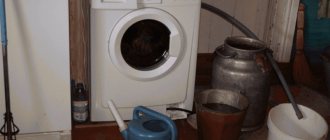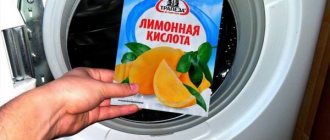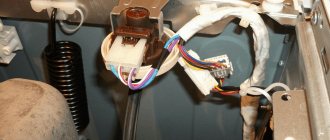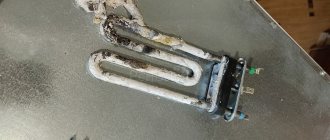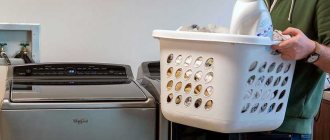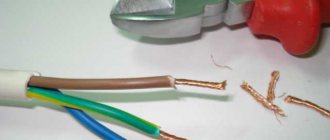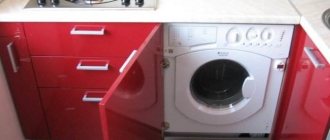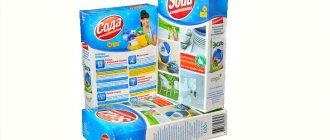How to organize laundry in the village?
To take advantage of automatic washing machines (WMA), you must have the appropriate amenities of civilization in your home:
- electricity;
- water supply with good pressure;
- sewer drain.
Everything is fine with the electricity supply in the villages, sewerage can be installed - not a big problem, but as for the water supply, everything is more complicated. Most villages do not have a water supply network, but even if they do, the pressure in it is not enough for the normal functioning of the SMA. The issue of organizing laundry at a dacha or in a country house has several solutions, let’s try to find the best.
Washing machines for the village
For rural areas, washing machines can be used:
- Semi-automatic. If you have a house without running water, a semi-automatic machine is a good solution. Liquid is poured into the tank from above - with a bucket or hose from some large container. The disadvantage of such machines is the need for human control. You need to add water, drain, rinse, and wring out.
- Mini washing machines. Small machines for the dacha - “Slavda”, “Fairy”, “Rainbow” and the like, are suitable for those who do a little laundry and have problems with water. These washing machines allow you to wash things without connecting to a water supply, and they use very little water. The capabilities of these machines are limited; their load is only 2–3 kg.
- SMA. Regular or with tank. True, in the first case you will have to tinker with organizing the water supply. For houses without water supply, the second option is more suitable.
Connecting a regular SMA without running water
Alternatively, if you have a regular automatic washing machine, it can also be adapted for your dacha, even if there is no central water supply. To use the machine fully, you will need to purchase water and drain tanks. These can be any containers with a volume of at least 50 liters. In order for the SMA to collect fluid and not display an error on the display, there must be a minimum pressure of the incoming fluid - 1 bar. This can be achieved in two ways:
- The container should be at a height of about 10 meters, in this case the pressure will be 1 bar.
- You can use a pump to increase the pressure.
It is recommended to use exactly the same pump that is installed in machines for pumping water. You can purchase it at specialized retail outlets or service centers.
The pump is installed between the SMA inlet valve and the fluid tank. For proper operation of the entire structure, synchronous operation of all elements (inlet valve and pump) is necessary. When the machine program signals that water is needed, voltage is applied to the inlet valve and it opens. If the pump is connected to the valve contacts, it will begin to work synchronously with it. When you need to draw liquid, the valve will open and the pump will start working. When there is enough liquid, the valve will close and, accordingly, the power to the pump will be turned off.
All connections must be sealed and electrical contacts must be insulated. The pump must have the same power (model) as in your washing machine to avoid damage to the unit due to excessive pressure.
As a result, it becomes clear that any type of washing machine can be adapted for your dacha, and the choice is limited only by your financial capabilities.
Automatic washing machines in the village
If the village has running water, then installing an automatic washing machine becomes quite possible. The main thing is that the pressure meets the technical requirements for the operation of the device. Usually it is possible to use the most undemanding and simple devices, designed for 3.5 kg and with a minimum speed of 600–800 rpm.
In principle, the lack of water supply is not an obstacle to the use of automatic washing machines. To operate correctly, machines without a tank require a water supply, and how it is organized is absolutely unimportant to the machine. If there is a well with a submersible pump, then water supply can be organized. The most difficult thing about connecting the SMA to water is ensuring the required pressure.
What if there is no running water?
The washing device is connected to a well, well or other autonomous source. Water supply is carried out by means of a pump. In principle, an ordinary container of water can play the role of a source.
Connection order:
- You need a 100 liter barrel and a stool 0.5 m high.
- A hole with a diameter of 5 cm is drilled in the stool.
- A hole is also drilled in the bottom of the barrel. Its diameter must match the external thread of the ball valve.
- The valve fitting is attached to the bottom of the barrel and tightened with a lock nut placed on the thread from the inside.
- The barrel is placed on a stool, the valve is passed into a hole drilled in the stool.
- Check the tightness of the barrel. If there is a leak, silicone is added under the locknut.
- They take a pump - the most ordinary one - and solder 1.5 m long wires to the power terminals.
- They open the housing, study the electrical circuits, and find a bypass valve that controls the filling of liquid.
- The SMA is usually connected to the water supply through a normally closed solenoid valve, which does not allow liquid to pass through until electricity is applied to the terminals. The pump contacts are connected to the wires leading to the valve - the shut-off device turns into a control relay. Then solder the wires from the pump to the valve terminals. The housing is closed and plugged into the network.
You won’t have to do any of this if you buy an SMA that already has a “barrel” attached to it. Such models are present in small quantities on the Russian market.
SMA with tank
The SMA with an additional water tank works exactly the same as conventional models. The tank attached to the body is the only difference between the “village” cars. However, their use is not limited to the private sector; such devices are often installed on the top floors of high-rise buildings where there is a lack of pressure.
The appearance and internal design of models with a reservoir are the same as their conventional counterparts. If you unhook the tank, the washing machine will take on the most ordinary appearance. It is mounted on the side or on the back wall, its capacity is 65–100 liters. The water supply is enough for several washes.
Features:
- Loading is front only.
- The tank volume is enough, depending on the selected mode, for 1–2 cycles.
- Liquid is supplied to the reservoir automatically or manually.
- The device collects liquid in the same way as devices connected to a centralized water supply do.
- If there is not enough water to continue the cycle, the device signals this - the user adds water, and this can be done during the cycle.
- Draining is done through the drain hose. Where to connect it is up to the user. You can drain the water into the sewer network, and if there is none, into any container of suitable volume.
How to start?
To start an SMA that works without connecting to a water supply, you need to perform a number of steps:
- Make sure the SMA is on a level surface.
- Check that the outlet is working properly and connect the device to it.
- Make the first run idle - without underwear.
- Add detergent, load laundry and add water. It doesn’t matter how you fill the container - manually or from the water supply. If there is a built-in pump, the device will take the required volume of liquid - 90–100 liters. Now you can turn on the device.
Advantages and disadvantages
Advantages of SMA with reservoirs:
- Allows you to do laundry “city style” in the village. There is no need to manually fill and drain water, wring out laundry by hand or transfer it to a centrifuge.
- No centralized water supply is required.
- You can wash clothes if there are any problems with water, which is why these machines can also be installed in city apartments - in case of water shortages.
- Economical consumption of electricity and water. The user has the ability to control the flow of water. If the supplied quantity is not enough, the device will signal that an additional portion is required.
- Many programs and modes.
Flaws:
- Large dimensions. This is especially true for small apartments and small private houses - a lot of space needs to be allocated for the device.
- There are models in which the tank is not detachable. Even if the owner no longer needs it, it can no longer be removed. This must be taken into account when installing the machine, or choose a universal model that can work both with a tank and with water supply.
- You have to control the amount of liquid in the tank and add it as needed.
What technologies?
Gorenje with a tank, like other machines, has enough technical capabilities for high-quality washing. Along with the usual technical solutions, they also have features that set them apart from their competitors.
Technologies and technical solutions used at Gorenje:
- The surface of the drum is ridged. With the help of ridges, liquid is captured from the bottom. This solution, the “Shower System,” improves the quality of washing.
- UseLogic - ensures minimal water consumption. Sensors monitor the purity of the water, determining whether additional rinsing is needed. For each cycle, the optimal volume of liquid is calculated, taking into account the weight of the laundry loaded into the drum.
- NickelHeater is a durable heating element. Has a smooth nickel-plated surface. Scale forms on it less actively.
- Balancing control system - for uniform distribution of laundry throughout the drum. As soon as an imbalance appears, the motor stops and then begins to rotate in the opposite direction.
How to choose an SMA with a tank?
When choosing a suitable model, pay attention to the following characteristics:
- Dimensions. For a spacious room, you can take the option with a side-mounted container. If there is a shortage of space, modifications in which additional capacity is located at the rear are more suitable.
- Volume. From 50 to 100 l. The larger the container, the better - you will have to fill it less often.
- Energy class. The optimal value is class A and higher.
- Water consumption. 9.2–9.3 thousand liters per year.
- Presence of a fill valve. This element is necessary to prevent overflow - but not all models have it.
- Spin speed. Up to 1000 rpm. The best option is a modification with a choice of spin speed.
- Loading. From 6 to 7 kg.
Types of washing machines
In order not to make a mistake in choosing, you need to understand which models are available on the market. There are two types of machines: drum and activator type. Nine out of ten buyers choose drum washing machines for ease of use and a large selection of washing modes. The units have a horizontally mounted drum, which is loaded with laundry and rotates in a tank filled with water. As you move from one stage of the cycle to another, the used water is replaced with clean water, heating up to the temperature set by the program. Detergents enter the tank from special compartments to which the inlet system hose is connected. After washing and rinsing, the machine spins the laundry, increasing the drum speed to maximum. Human participation in the washing process is minimized: just load the clothes, add detergent, and at the end of the cycle take out almost dry items.
The main advantage of drum-type machines is that all washing processes are performed in one drum with minimal human intervention
Drum machines come with front and vertical loading. Front-mounted models are quite bulky and can take up a lot of space, but they are easier to integrate under a countertop or place under a sink, saving space. Appliances with vertical loading are often more compact, and when installed in front of the washing machine, there is no need to leave free space to open the door (clothes in such units are placed in the tank through the top cover). These features should be considered before purchasing.
A drum-type machine with vertical loading is suitable for small spaces
The simplest activator-type washing machines contain a vertical fixed tank, an activator and a timer. Heated water is poured in manually or using a special hose. At the bottom of the tank or in its side there is a disk (activator) with special ribs that rotate the laundry in the water along with the detergent. Rinsing is done in an external container, for example, under a tap, in a basin, in a bathtub, etc. Such a washing machine does not require a connection to the water supply and sewerage system.
The simplest activator machines do not spin laundry; this option is only available in devices with a built-in centrifuge. In such devices, washed wet laundry must be transferred into a separate tank manually and the spinning process must be started additionally. The laundry will have to be dried, preferably in the open air. An improved option is activator machines with a built-in heating element that provides water heating. This makes the housewife’s work easier and increases the quality of washing.
The main advantages of activator machines:
- independence from water supply and sewerage;
- resistance to power outages;
- shorter washing time compared to drum models;
- economical use of water;
- the ability to add items during the washing process;
- loading laundry through the top lid.
A mini washing machine with a spin for the garden does not take up much space and performs all the necessary functions
Another advantage of small activator-type washing machines for cottages is the cost, which is often 2 times less than the simplest drum models. You can learn more about washing machines of this type from our article “Activator-type washing machine.”
A separate category of mini washing machines for dachas are models of the “Baby” type . They are ideal for summer residents with minimal requirements. Units of this type resemble a small tank, designed to hold a couple of kilograms of things or several items of clothing. Water is poured into them manually, the drain is located at the bottom and is screwed in with a plug; The machine does not require any water supply or sewage system to operate.
The equipment is ideal for washing one work set, soiled during a day of work at the dacha. This is the most affordable and economical option for a machine that can be easily loaded into a car and taken with you to your apartment for the winter.
The photo shows one of the models of “Malyutka” washing machines.
If your dacha does not have running water, but you want to purchase an automatic machine with full functionality, you need to choose from washing machines with a built-in tank . The container usually has a volume of 100 liters and is attached to the rear or side wall of the unit. The collected water will be enough to complete 1-2 washes. You can learn more about washing machines of this type from our article “Automatic washing machine with a water tank.”
The Gorenje brand offers several options for machines with an additional tank
Review of models and consumer reviews
On the domestic market, SMA with tanks is offered by the Gorenje brand. Let's take a closer look at the options presented to our customers.
Gorenje WP 7Y2/RV – with water tank
A machine from a Slovenian brand at a competitive price and with good parameters:
- Capacity: 7 kg.
- Spin speed: up to 800 rpm.
- Number of programs: 16 pcs. (including Delicate, Economy, Mixed fabrics, washing in large volumes of water and others).
- Energy efficiency class: A++.
- Washing/spin classes: A/D.
- Safety: protection against leaks, child lock, imbalance and foam level control.
- Dimensions (WxDxH): 60x55x85 cm.
- Noise level (washing/spin) - 57/73 dB.
- Additionally: anti-allergy, self-cleaning.
Pros:
- Large set of programs.
- All types of protection.
- Electronic convenient control.
- Ability to work without running water.
Minuses:
- Low spin class - the laundry will remain partially wet.
On a note! Perhaps the manufacturers did not specifically focus on spinning, because the machine is designed primarily for rural areas, where clothes are often dried in the fresh air, and residual moisture does not play a special role.
W 64Z02/SRIV - narrow
This narrow machine, like the previous model, has a removable lid for embedding. But her tank is mounted not on the side, but on the back. The control panel has a digital display and a rotary knob for switching modes. This version is suitable for families with children - appropriate locking is provided. There is a timer that allows you to delay the start for up to 24 hours. The hatch can open 180 degrees - this simplifies the loading of laundry. Reservoir - 65 l.
- Capacity: 6 kg.
- Drying: no.
- Water consumption: 51 l per cycle.
- Spin speed: 1000 rpm.
- Number of programs: 23 pcs. (including washing delicate fabrics, sportswear, quick, pre-wash).
- Energy efficiency class: A++.
- Washing/spin classes: A/C.
- Safety: partial protection against leaks, child protection, imbalance and foam level control.
- Noise level (wash/spin): 56/68 dB.
- Dimensions (WxDxH): 60x44x85 cm.
- Weight: 69 kg.
Advantages:
- Removes stains efficiently.
- When connected to a water supply, it operates at low pressure. The user connected the container to the village water supply with a pressure of 2 liters per minute. The container is slowly filled through a hose, and then the washer pumps as much as needed into the drum.
- There is control of the liquid level in the container.
- Compared to the side mounting of the tank, the dimensions are more convenient.
- There is a quick wash for 17 minutes.
- There is an “anti-allergy” mode.
- Quiet operation.
Flaws:
- Lots of unnecessary programs. Users note that they use 4–5 pieces, no more.
Expert opinion. You won't please your users. If there were 5 programs, they would definitely write that there are too few. So this is not a disadvantage.
One user notes that after three years of operation the pump broke. The repairman who carried out the repair said that he would work for the same amount of time. For modern technology, 6–7 years of service is not so bad. This model has become a real gift for many rural residents, especially pensioners - they can finally wash all the laundry in the house with high quality without making any effort.
This relatively inexpensive model is designed for small washes - the drum load is only 6 kg. Compared to the previous version, the W 64Z02/SRIV has very limited capabilities. The container will have to be filled more often, and the laundry will have to be loaded less often. But there is a display and a child lock, which is not observed in the previous modification.
LG F-2J6WS0W – with surge protection
The model is equipped with protection against power surges - what you need if your village or dacha cooperative has problems with this. The only disadvantage of this functionality is that when there is a power surge, the machine will stop working and wait for the voltage in the network to normalize. But its electronics will be reliably protected from breakdowns.
Characteristics:
- Capacity: 6.5 kg.
- Spin speed: up to 1200 rpm.
- Number of programs: 14 pcs. (including Delicates, Economy, Nightwear, Blacks, Mixed fabrics and others).
- Energy efficiency class: A++.
- Washing/spin classes: A/B.
- Safety: protection against leaks, child lock, imbalance and foam level control.
- Dimensions (WxDxH): 60x45x85 cm.
- Noise level (washing/spin) - 56/74 dB.
- Additionally: hypoallergenic washing, possibility of reloading laundry.
Pros:
- Compact and roomy.
- The weight of 63 kg does not allow the machine to “run away” when spinning at high speeds.
- Steam wash.
- Stylish design.
- Large hatch.
- Quiet operation.
- It is possible to create your own program (but it is not saved).
- Collapsible (repairable) tank.
- Adjusting the temperature from 20 to 95 degrees, spin from 400 to 1200.
- Supplied with a hose and a coarse filter.
- NFC for installing additional programs.
Minuses:
- Vibrates during spin cycle.
- Russian-assembled models are not of the highest quality.
- Water remains in the gum.
- There is no backlighting of the touch keys, they are difficult to read.
- The instructions are for the entire line, not this individual model.
- NFC only works at close range.
Automatic washing machines with tank
A washing machine with a tank can work where there is no running water or the water pressure in the system is too low. These are automatic drum-type units that have all the necessary functions. Water enters the washing machine tank from an external container, which is attached to the body at the back or side. Water can be poured into the tank manually or automatically, for example, when connected to a well. There are few models of this type, since there is only one manufacturer of such equipment on the market - the Slovenian company Gorenje.
Gorenje W64Z02/SRIV
This model has dimensions of 60 x 44 x 85 cm and belongs to the category of narrow SM, but a water tank with a capacity of 65 liters is attached to the back. If we take into account that during one working cycle the ASM consumes 51 liters of water, then the capacity of the container is enough for 1 wash. The maximum drum load is 6 kg of laundry.
Front ASM Gorenje W 64Z02/SRIV with water tank
The model has a washing class A. The drum spins clothes according to class C, rotating at a speed of up to 1000 rpm. Electricity consumption corresponds to class A++. The SensoCare system analyzes information from touch sensors, determining the weight and degree of contamination of loaded items, and based on the results sets the temperature, amount of water, time and spin speed.
15 programs are stored in the control unit’s memory, including washing cotton, wool, synthetics, delicate fabrics, sportswear, super black and ultra white laundry. Direct injection, pre-wash, quick wash, overnight wash and express wash modes are available. The housing is protected from water leaks and is childproof.
Gorenje W72ZY2/R
The unit has dimensions of 60 x 60 x 85 cm and is capable of washing up to 7 kg of laundry at a time. SM can be built under the tabletop. A tank with a capacity of 100 liters is connected to the machine. Water consumption is economical: up to 54 liters are consumed per one cycle of operation.
The quality of washing is at the highest level (class A). Spin efficiency corresponds to class D, the drum rotates at speeds of up to 800 rpm. Energy efficiency class – A++. The safety system consists of three components: protection of the housing from water leaks, control of imbalance and foam formation.
There are 18 programs for operation, including washing in a large amount of water, quick, delicate, express wash, rinse.
Washing machine Gorenje W72ZY2/R with water tank
Gorenje W72ZX1/R+PS PL95
The ACM, with the ability to be built under a tabletop, has dimensions of 60 x 60 x 85 cm and weighs 77 kg. Can wash up to 7 kg of laundry at a time. The machine does not have a display, but the washing modes are displayed using indicators. Modes are controlled using a switch, additional functions are selected using buttons.
Front washing machine with tank Gorenje W 72ZX1/R+PS PL95
The washing quality corresponds to the highest class A. Spin efficiency is at the level of class D. The drum can reach speeds of up to 800 rpm. Energy efficiency class – A++. One standard wash cycle uses up to 56 liters of water. The capacity of the external tank is 100 l.
The unit is equipped with 18 programs, including washing cotton, wool, synthetics, and delicate fabrics. There are eco-friendly, manual and quick wash modes. There is complete protection against water leaks and against children, as well as control of foam levels and imbalances. ACM works quietly: the noise level during washing/spin is 58/71 dB.
Choosing a car for your summer cottage is not difficult: among the huge variety of models, it is easy to find equipment that suits any capabilities and needs. Many activator SMs are in no way inferior to drum-type machines in their characteristics, and even surpass them in reliability, since they have a simple device.
conclusions
Let's summarize:
- The best solution to the problem of washing in the village is the Gorenye model with tanks.
- An additional tank can be filled with water - well, rain, etc.
- Lack of running water is not a reason to refuse SMA.
- Thanks to washing machines with additional capacity, rural users are freed from unnecessary fuss with laundry.
The problem of laundry in the village is best solved by SMA from Gorenje. Today this is the simplest and most effective way to wash clothes efficiently. The process differs in only one stage - collecting water into the tank.


